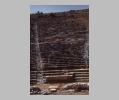| Summary: | One of the major Mycenaean and ancient city-states of the Peloponnese. |
| Type: | Fortified city |
| Region: | Argolid |
Periods:
Early Bronze Age
Middle Bronze Age
Late Bronze Age
Dark Age
Geometric
Archaic
Classical
Hellenistic
Roman
Byzantine
Modern
Physical:
Argos lies ca. 7 km inland, near the center of the 200 square km Argive plain, and between the bases of the Aspis and Larissa hills and the Kharadros river. The W half of the modern town of Argos covers the ancient city and excavations have been limited to small areas and rescue work. Features that have been excavated or investigated include the theater, agora, sanctuary of Apollo and Athena, the Roman odeion and baths, and sections of the Classical circuit wall.
Description:
Traditionally Argos was claimed as one of the oldest cities of ancient Greece, and the birthplace of Perseus, the son of Danae and Zeus. Some Neolithic remains have been found in the area, but the best evidence for early occupation is the Early to Middle Helladic settlement on the summit of Aspis. By Mycenaean times the center of settlement had moved to the higher Larissa hill to the W (where the Frankish castle now stands).
Although Argos was a major Mycenaean center and its citizens figure prominently in the Homeric epics, the city was over-shadowed by nearby Mycenae. After the fall of the Mycenaean Empire Argos seems to have had the predominant role in the Peloponnese until the 6th century B.C. when it begins a long struggle with Sparta. Throughout the Classical period Argos allied itself with Corinth or Athens against Sparta. In 229 B.C. Argos joined the Achaean League and after 146 B.C. it became part of the Roman province of Achaea. Substantial Roman building activity indicates prosperity in the 1st to 5th centuries A.D.
Argos was capital of King Pheidon and home of sculptors Ageladas and Polykleitos.
Exploration:
In 1892, I. Kophiniotis partially excavated the theater; between 1902 and 1930 W. Vollgraff carried out several excavations on behalf of the French School. French School excavations have continued under the direction of G. Daux and P. Courbin since 1952.
Sources Used:
Other Bibliography:





